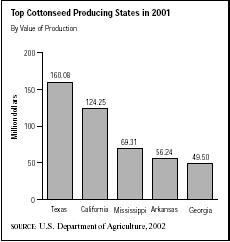SIC 2074
COTTONSEED OIL MILLS
This category covers establishments primarily engaged in manufacturing cottonseed oil, cake, meal, and linters, or in processing purchased cottonseed oil into forms other than edible cooking oils. Businesses primarily involved in refining cottonseed oil into edible cooking oils are covered in SIC 2079: Shortening, Table Oils, Margarine, and Other Edible Fats and Oils, Not Elsewhere Classified.
NAICS Code(s)
311223 (Other Oilseed Processing)
311225 (Fats and Oils Refining and Blending)
The first successful cottonseed oil mill began production in Natchez, Mississippi, in 1833. Up to that point, cottonseed left over from planting had been regarded as a health hazard and a source of pollution. The cottonseed industry grew swiftly after the Civil War, making the United States the largest consumer of cottonseed in the world. Total U.S. cottonseed production reached 7.45 million tons in 2001. In 2002 production fell to 6.41 million tons, according to the National Agricultural Statistics Service (NASS). The value of production fell from $667 million in 2001 to $638 million in 2002, as prices increased from $90.50 per ton to $100 per ton over the same time period.
The milling of raw cottonseed yields three products: hulls, linters, and kernels. The hull is typically used as livestock feed, the linters are used for the manufacturing of various products, and the kernels are crushed for oil and meal production. Cottonseed meal typically represents 60-80 percent of total crushed production. Aside from its role in the production of salad dressings, margarine, and shortening, the chief use for the oil is in the manufacture of lubricants, paint, and soap. The principal use for cottonseed meal is as a high-protein feed supplement for cattle, swine, and poultry, and it is also used as a fertilizer. In 2000, U.S. meal production totaled 1.29 million tons, and oil production reached 818,000 tons. Approximately 2.6 million tons of cottonseed was crushed.
Before the crushing of cottonseeds, but after the removal of the longer fibers processed in the manufacture of fabrics, the linters—shorter cotton fibers—are removed by a range of methods suited to their various uses in the production of sterile absorbent cotton, felt, and padding; in the manufacture of paper, film, explosives, plastics, and rayon; and as a source of essentially pure cellulose for the chemical industry.
Mill-run processing of linters is a one-step procedure used for smaller quantities than are handled in alternative processing methods. Various production approaches yield both longer and shorter linters for use either in the chemical industry or for other purposes. A two-step processing method yields, at the first stage, the longer and softer first-cut linters well suited to the production of absorbent cotton, felt, and padding. At the second stage (the portion of the production process that generally represents the bulk of total linter production), the shorter and tougher second-cut linters usually reserved for use in the chemicals industry are garnered.
Any part of cottonseed intended for consumption by humans or by nonruminant (not hoofed) animals must be processed in such a way as to extract the gossypol, a

pigment toxic to all nonruminants. Because this pigment is located in the tiny glands of cottonseed, the development of a glandless strain of cottonseed was seen as holding potentially great promise for the future of the cottonseed industry. In the mid-1990s a new cottonseed variety with a "healthier" high-oleic acid profile was developed, which could increase market share for cotton in the cooking and salad oil industries traditionally dominated by soybean oil.
U.S. exports of cottonseed oil in 2001-2002 were highest to Canada (29,949 metric tons) and Mexico (9,666 metric tons). Japan and El Salvador followed with 7,219 metric tons and 3,550 metric tons, respectively. Mexico received the most cottonseed meal and cake at 121,783 metric tons. The only country with higher cottonseed production than the United States in 2002 was China with 9.5 million metric tons.
Further Reading
U.S. Department of Agriculture, National Agricultural Statistics Service. "Statistics of Oilseeds, Fats, and Oils." Washington, DC: 2003. Available from www.usda.gov/nass/pubs/agr03/03_ch3.pdf .
Comment about this article, ask questions, or add new information about this topic: